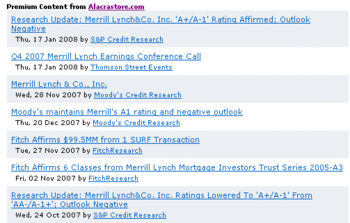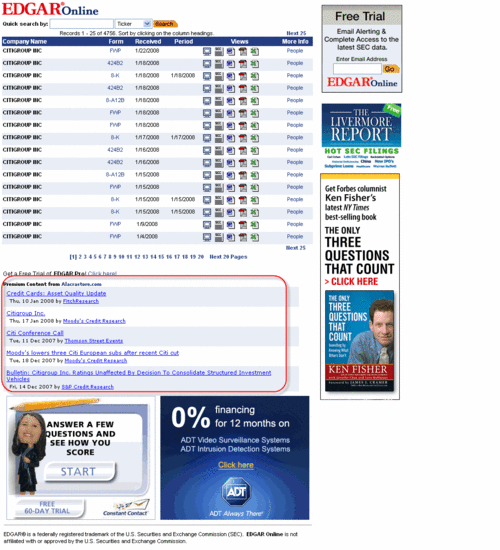 It’s been a busy January. Most years, I’ve posted my themes & predictions by New Year’s day. This year, it’s almost February and I’m just getting this out.
It’s been a busy January. Most years, I’ve posted my themes & predictions by New Year’s day. This year, it’s almost February and I’m just getting this out.
First, a quick look back at my predictions for 2007:
- Growth in vertical search – didn’t really happen
- Changes in web advertising models and metrics as page views become less important due to AJAX and UGC. This one was a big issue and Nielsen/NetRatings dropped use of page view by mid-year.
- Further consolidation in the industry/heavy M&A: record-setting year.
- Rollup of blogging tools: Most of the companies I mentioned in this paragraph (Feedburner, MyBlogLog, Last.fm) were acquired; just not by the same company.
- MySpace jumps the shark: While Facebook had the stronger growth during 2007, MySpace continued with steady growth. The predicted slowdown didn’t happen.
- RSS Gains Adoption: sort of, but not really
- Widgets gain prominence: Thanks to Facebook, widgets skyrocketed in 2007.
- Drop in newspaper readership accelerates: OK, sort of like predicting that the sky will be blue, so I’m not taking too much credit for this one.
I score that five out of eight, slightly better than my usual 50%.
Let’s take a look at what 2008 might have in store.
 The economy will hang heavily over all business, especially during the first half of the year.
The economy will hang heavily over all business, especially during the first half of the year.
Both b2b and b2c content businesses are likely to see revenue declines. On the b2b side, the first thing that goes in a week economy is the peripheral user. When asked, most business leaders will tell you that the bulk of their customers are “core users”. In reality, for most businesses, it’s probably half that. So, half of your users have been paying for subscriptions but can’t quantify the value you provide. 2008 may be the year that many of those casual users choose not to renew.
That creates opportunity, of course, for new business models. Advertising-supported or freemium businesses may be well-positioned to take users away from long-established paid content providers. Providers like ZoomInfo may not be as good as the incumbents they replace, but for free, they may be good enough.
Slowdown in M&A
The second economic impact will likely be a slowdown in M&A. 2007 was a record-setting year for M&A in the content industry. According to Jordan, Edmiston, there were 838 transactions worth nearly $108 billion, nearly the sum of the prior two years combined.
With lending tight, at least for the first half of the year, it will be harder to do large acquisitions. On top of this, some of the more active strategic buyers in the past, such as Thomson, Reuters and Dow Jones, will be busy digesting their 2007 deals and may have a lower appetite for new deals. That said, this could finally be the year that Yahoo gets acquired, either by Microsoft or perhaps by private equity.
Yet 2008 will not be all bad for M&A. For European and Asian acquirers, the weak US dollar makes it seem like everything’s on sale. While private equity deals may be down a bit this year, cross-border strategic acquisitions will keep the deal flow alive.
A great time for startups
The weak economy could be a good time for startups, however.
It’s never been less expensive to get a content or technology startup off the ground than now. Hosted technology solutions mean you can buy an off-the-shelf technology infrastructure at a fraction of what it would cost to build it out yourself. Meanwhile, as legacy businesses see their revenues erode, they’re less likely to test out new revenue models or launch new products. For nimble startups with low cost structures, this can be a great time to gain a foothold into a market.
The financial markets may also yield opportunities for startups. Thomson and Reuters will be distracted by the internal politics of combining their two businesses. At the same time, financial institutions often require multiple sources for key databases. The consolidation of Reuters and Thomson may leave only a single source, creating opportunities for others to become the alternative supplier.
The other big issue for 2008 will be the Elections.
The hot races in both parties have helped take the sting out of the writers’ strike for the networks. So far, little election spending has made its way online, but I think that will begin to change as the campaigns move from the retail politics of New Hampshire and Iowa to the broader media campaigns of the national election. Lehman forecasts that $110 million will be spent by candidates in online advertising. More important than the advertising dollars could be the continued large roles of blogs and user-generated content as primary sources for political knowledge.
The elections also create an interesting opportunity for startups. Mashing up campaign contributions with legislative records or voting results with census data could generate really great websites that the media and public will eat up. Lots of this information is publicly available, so it’s there for the picking.
Revenue models emerge for social networks
As users spend more and more of their time online using social networks, it’s inevitable that viable business models will emerge. While 2007 was definitely the year of Facebook, I think it’s likely that the Google-led OpenSocial will be a big player during the second half of 2008. I had truly expected Facebook to position itself as a solid b2b platform by now, but they’ve shown little interest in doing so. That should leave a void that can be filled by LinkedIn, who are already the dominant player for business social networking. If they embrace the “open” aspect of OpenSocial, they could entrench themselves as the players to beat.
The emergence of widgets was one of my themes for 2007. In 2008, widgets will become more important as users look to get your content "their way". Visits to traditional destination sites will be down and content providers who don't widgetize their information will see usage drop accordingly.
Video hits b2b
Until now, video has largely been a consumer play. While some markets will be slow adopters (for multiple reasons I don't see it playing on the financial trading floor), video will start to penetrate the corporate market this year.
So, there they are. Trends & predictions for 2008.
As always, I welcome your thoughts in the comments.
![]() Who is your customer? Is it the consumer or the advertiser?
Who is your customer? Is it the consumer or the advertiser?








